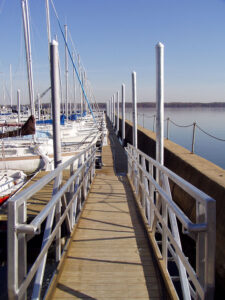A dock lift is an excellent investment for a boat owner. Not only does it save time, but it also protects the watercraft from corrosion and extends its lifespan.
These lifting devices are more versatile than truck well recesses and ramps, as they can line up loads to any bed height with the push of a button. Dock Lifts Charleston SC is the ideal solution for a wide range of trucks including low-step vans and pickups too high reefer semis.

Safety
In addition to improving productivity and reducing cost, dock lifts significantly improve worker safety. They help employees move materials more efficiently and safely compared to other methods of off-loading trucks. They can also work with multiple vendors’ trucks, which is not possible with truck tailgates. Unlike loading dock levelers, dock lifts provide the flexibility of lining up loads to any truck bed height.
Workers who use loading dock lifts can avoid back, shoulder, and hand injuries by not having to manhandle materials between truck beds and ground level. Other ways to move goods from truck to trailer include unstacking pallets on the truck, pushing the material in front of a forklift, or rolling them down a ramp. These methods often involve strenuous movements and are prone to mistakes that can lead to expensive damage.
The ability to operate a boat lift in calm water reduces the structural stress on the lift and dock. This allows the lifting system to work more effectively and eliminates damage to both the lift and the boat. A standard-built lift is sufficient for most boat locations in calm water.
A dock lift is much safer than a truck tailgate, as it does not require a cab to open and close. Additionally, dock lifts do not increase wear on the truck or cause a loss in capacity as truck tailgates can do. Moreover, dock lifts have a much greater operating range than truck tailgates, which increases the operational efficiency of a loading dock.
Using a dock lift is safe, especially for workers with physical limitations. Using a truck tailgate requires the operator to climb onto the vehicle, putting them at risk of falling off. In contrast, dock lifts have a sturdy handrail for operators to hold on to as they move materials in and out of trucks.
A loading dock lift can also help prevent accidents caused by reversing trucks. When a truck is reversing and does not see an employee, the truck can crush it between itself and the edge of the dock. Dock lifts keep workers on a level surface, and the automated system allows them to align load levels with any truck bed height.
Convenience
A dock lift is a convenient way to keep your boat out of the water when it’s not in use. This will protect it from damage and make it easier to access when you are ready to go on a ride. It also helps to extend the life of your boat and adds value to your property.
If you are in the market for a new boat lift, it is important to find one that is compatible with your current dock. To do this, take measurements of your dock slip width and the size of your boat to ensure that you can fit your boat safely into the lift. It is also a good idea to consult with a professional when selecting a dock lift. They will be able to help you choose a lift that will meet your needs and budget.
Dock lifts offer several convenience benefits that you won’t get from more traditional loading solutions such as dock levelers. Using them to move goods from ground level up to truck beds is much safer than doing it manually. It reduces the risk of back, shoulder, and hand injuries. These types of injuries are caused by repetitive motions, lifting heavy objects, and twisting and turning.
Another advantage of dock lifts is that they take up less space than ramps. They can be either affixed to the dock or mounted on the ground. They can be portable or permanent installations and can line uploads at different truck bed heights with the push of a button. They are more versatile than ramps and can accommodate a variety of truck sizes from low step vans to large reefer semis.
Another benefit of dock lifts is that they increase productivity by reducing the amount of time spent on loading and unloading. They can even eliminate the need for truck tailgates, which are a common cause of safety issues on the job site. Choosing the right loading dock lifts requires a hands-on design process that allows owners to touch and feel products, materials, and equipment first-hand. This will help ensure that expectations are met and will result in optimal performance.
Flexibility
The dock lift allows you to bridge the gap from the warehouse floor to the trailer bed, providing a safer and more convenient loading environment for your employees. It also eliminates the need for a ramp or grade-line door, which can be dangerous for workers and increase your insurance premium. It is a great option for facilities with low or high dock heights, and it can handle a wide range of truck sizes from small box trucks to large reefers. It can be lowered from the warehouse floor or mounted on the dock, and it is easy to install on a variety of types of buildings.
In addition, the use of a pit lift can reduce worker fatigue caused by stepping up into trailers or walking up a ramp. Its design can be customized to match the exact specifications of your facility and loading dock. It can also be integrated with Internet of Things (IoT) technologies to improve safety and predictive maintenance.
When selecting a dock lift, it’s important to take into account the size and weight of your boat. The water depth in your area may also affect the type of lift you need. In some cases, the water levels rise and fall throughout the year. Therefore, it’s important to select a lift that can float with the water level.
A dock lift can help you save time and money by eliminating the need to transport your boat. It can also increase the value of your property, especially if you live near a lake or river.
Lastly, the lift can also help you protect your boat from theft and other problems. It’s best to secure your boat above the water, and a lift can prevent others from accessing your boat without permission.
The design process is the most critical stage in a dock and lift project. It’s essential to find a service that offers a hands-on design process for optimal results. This ensures that the materials and equipment selected will be a good fit for your needs. It will also help you avoid bad surprises and unnecessary upgrades down the road.
Cost
Most dock lifts have a much lower cost than traditional loading solutions like truck wells and concrete ramp construction. Furthermore, they are easier to install and provide quicker payback compared to both. They also allow you to accommodate a wide range of trailer heights, and they improve safety by providing a safe bridge between the dock and the vehicle bed. In addition, pit lifts can be easily upgraded and are less expensive to maintain than traditional dock levelers.
When choosing a dock lift, it is important to consider the location of your boat slip. Rough water locations require a heavy-duty lift with a thicker structure. This extra strength prevents damage to the lift, dock, and boat and reduces the risk of corrosion. It is also essential to choose a lift that is designed to fit your slip width to avoid bumping and other inconveniences.
Another advantage of using dock lifts is that they help prevent back, shoulder, and hand injuries. Traditional docking methods involve manual handling and require lifting, twisting, and turning, which can lead to costly injuries. However, with dock lifts, workers are standing on a level surface and can easily move goods from the truck to the ground.
Dock lifts can be mounted either on the edge of your dock or in a dock pit. While recessed dock lifts are cheaper, they can cause drainage problems and interference with underground utilities. For this reason, many users opt for top-of-ground dock lifts that don’t require pit construction. Top-of-ground units also have a higher load capacity than recessed units, and they can be upgraded with various options.
When buying a dock lift, be sure to select one with an appropriate slow-speed drive-over capacity. This allows you to use the lift in a fully lowered position and is often more than sufficient for most applications. However, if you have large specialty vehicles or high-capacity fork trucks, a higher limit may be necessary. In addition, it’s a good idea to include a limit switch on the power unit for added safety.
